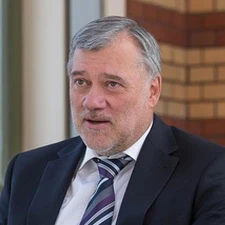Jürgen Kurths

The 2013 Lewis Fry Richardson Medal is awarded to Jürgen Kurths for his development of crucial new concepts and tools in the synchronisation of coupled chaotic oscillators and in recurrence networks, and for their innovative application to climate dynamics and nonlinear geosciences in general.
Jürgen Kurths is truly an exceptional scientist. His contributions to the area of nonlinear processes in the geosciences are diverse and highly original, and his work has had considerable impact on the field. He has developed important new methods in nonlinear time series analysis, such as synchronisation and recurrence analysis, and also has also made major contributions to other subjects, such as synchronisation processes in the human brain. Kurths’ work on synchronisation of coupled chaotic oscillators has led to the wide use of phase synchronisation and lag synchronisation in the analysis of networks of oscillators, and his work on coherence resonance has added considerably to our understanding of resonances in general.
In nonlinear data analysis, he introduced recurrence-based measures of complexity, as well as the study and characterisation of recurrence networks and of network of networks. These ideas and methods have opened new branches of theoretical research, and have triggered key applications in the Earth sciences and sustainability. Nowadays, the phenomena discovered and the methods introduced by him and his collaborators are included in several textbooks. Kurths’ great strength is the combination of modern mathematical methods and a broad interest in the field of nonlinear processes. He and his group have recently given the application of complex network theory to climate a substantial degree of maturity. His studies of recurrence and synchronisation have helped elucidate the relationships between major climate processes, such as the Indian monsoon, the El Niño–Southern Oscillation and the North Atlantic Oscillation. Among other areas of the geosciences he worked on and influenced are earthquake prediction studies based on the concept of Earth’s lithosphere as a nonlinear system. It is a characteristic of Kurths’ work to be cited in fields far from the discipline that gave rise to the initial idea, a characteristic shared with the work of Richardson himself.
Kurths maintains a large network of scientific collaborators and many of his PhD students and postdocs are making in turn noteworthy contributions to nonlinear dynamics and the geosciences. Their personal and professional development and their subsequent success have much to do with Kurths’ positive, supportive, generous, and nurturing personality. Kurths has been a leader in many international scientific activities, including the presidency of the EGU Nonlinear Processes in Geosciences Division (2000-2005). He is currently an executive editor of the EGU journal Nonlinear Processes in Geophysics. In conclusion, Jürgen Kurths has achieved exceptional international standing in the field of nonlinear processes in the geosciences and he is therefore highly deserving of the Lewis Fry Richardson Medal.
Publication resulting from this medal
Kurths, J., Agarwal, A., Shukla, R., Marwan, N., Rathinasamy, M., Caesar, L., Krishnan, R., and Merz, B.: Unravelling the spatial diversity of Indian precipitation teleconnections via a non-linear multi-scale approach, Nonlin. Processes Geophys., 26, 251–266, https://doi.org/10.5194/npg-26-251-2019, 2019.
